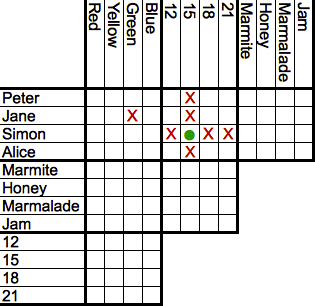|
Logic Maze
Logic mazes, sometimes called mazes with rules or multi-state mazes, are logic puzzles with all the aspects of a tour puzzle that fall outside of the scope of a typical maze. These mazes have special rules, sometimes including multiple states of the maze or navigator. A ruleset can be basic (such as "you cannot make left turns") or complex. Popular logic mazes include tilt mazes and other novel designs which usually increase the complexity of the maze, sometimes to the point that the maze has to be designed by a program to eliminate multiple paths. History Robert Abbott invented the logic maze. The first logic maze ever published, ''Traffic Maze in Floyd's Knob'', appeared in the October 1962 issue of ''Scientific American'' in the ''Mathematical Games'' column. Abbott 1997, pp. vii-ix Examples ''Theseus and the Minotaur Theseus and the Minotaur is a type of logic maze designed by Robert Abbott. In this maze, the player acts as Theseus, the king of Athens who is attemp ... [...More Info...] [...Related Items...] OR: [Wikipedia] [Google] [Baidu] |
Logic Puzzle
A logic puzzle is a puzzle deriving from the mathematics, mathematical field of deductive reasoning, deduction. History The logic puzzle was first produced by Charles Lutwidge Dodgson, who is better known under his pen name Lewis Carroll, the author of ''Alice's Adventures in Wonderland''. In his book ''The Game of Logic'' he introduced a game to solve problems such as confirming the conclusion "Some greyhounds are not fat" from the statements "No fat creatures run well" and "Some greyhounds run well". Puzzles like this, where we are given a list of premises and asked what can be deduced from them, are known as syllogisms. Dodgson goes on to construct much more complex puzzles consisting of up to 8 premises. In the second half of the 20th century mathematician Raymond Smullyan, Raymond M. Smullyan continued and expanded the branch of logic puzzles with books such as ''The Lady or the Tiger?'', ''To Mock a Mockingbird'' and ''Alice in Puzzle-Land''. He popularized the "knights an ... [...More Info...] [...Related Items...] OR: [Wikipedia] [Google] [Baidu] |
Tour Puzzle
A tour puzzle is a puzzle in which the player travels around a board (usually but not necessarily two-dimensional) using a token which represents a character. Maze puzzles are often of this type. Sometimes the player has more than one token with which to travel. Sometimes certain objects have to be found or retrieved on the way. In the case of large hedge mazes, the player makes the trip themselves instead of a token. Often there is a given start and finish position for the player's token. Some tour puzzles demand that certain points on the board have to be visited on the way. Examples of tour puzzles * knight's tour * mazes and labyrinth In Greek mythology, the Labyrinth (, ) was an elaborate, confusing structure designed and built by the legendary artificer Daedalus for King Minos of Crete at Knossos. Its function was to hold the Minotaur, the monster eventually killed by ...s * mizmazes * logic mazes * Hiroimono References {{DEFAULTSORT:Tour Puzzle Puzzles< ... [...More Info...] [...Related Items...] OR: [Wikipedia] [Google] [Baidu] |
Maze
A maze is a path or collection of paths, typically from an entrance to a goal. The word is used to refer both to branching tour puzzles through which the solver must find a route, and to simpler non-branching ("unicursal") patterns that lead unambiguously through a convoluted layout to a goal. The term "labyrinth" is generally synonymous with "maze", but can also connote specifically a unicursal pattern. The pathways and walls in a maze are typically fixed, but puzzles in which the walls and paths can change during the game are also categorised as mazes or tour puzzles. Construction Mazes have been built with walls and rooms, with hedges, turf, corn stalks, straw bales, books, paving stones of contrasting colors or designs, and brick, or in fields of crops such as corn or, indeed, maize. Maize mazes can be very large; they are usually only kept for one growing season, so they can be different every year, and are promoted as seasonal tourist attractions. Indoors, mirror ma ... [...More Info...] [...Related Items...] OR: [Wikipedia] [Google] [Baidu] |
Robert Abbott (game Designer)
Robert Abbott (March 2, 1933February 20, 2018) was an American game inventor, sometimes referred to by fans as "The Official Grand Old Man of Card Games". Though early in his life he worked as a computer programmer with the IBM 360 assembly language, he began designing games in the 1950s. Abbott 1962, p. 53 Two of his more popular creations include the chess variant Baroque chess (also known as Ultima) and Crossings, which later became Epaminondas. Eleusis was also successful, appearing in several card game collections, such as ''Hoyle's Rules of Games'' Morehead 2001, p. 67 and ''New Rules for Classic Games'', Schmittberger 1992, p. 74 among others. In 1963, Abbott himself released a publication, ''Abbott's New Card Games'', which included instructions for all of his card games, in addition to Baroque chess. Abbott 1963 Abbott also invented logic mazes, the first of which appeared in Martin Gardner's ''Mathematical Games'' column in the October 1 ... [...More Info...] [...Related Items...] OR: [Wikipedia] [Google] [Baidu] |
Scientific American
''Scientific American'', informally abbreviated ''SciAm'' or sometimes ''SA'', is an American popular science magazine. Many famous scientists, including Albert Einstein and Nikola Tesla, have contributed articles to it. In print since 1845, it is the oldest continuously published magazine in the United States. ''Scientific American'' is owned by Springer Nature, which in turn is a subsidiary of Holtzbrinck Publishing Group. History ''Scientific American'' was founded by inventor and publisher Rufus Porter (painter), Rufus Porter in 1845 as a four-page weekly newspaper. The first issue of the large format newspaper was released August 28, 1845. Throughout its early years, much emphasis was placed on reports of what was going on at the United States Patent and Trademark Office, U.S. Patent Office. It also reported on a broad range of inventions including perpetual motion machines, an 1860 device for buoying vessels by Abraham Lincoln, and the universal joint which now can be found ... [...More Info...] [...Related Items...] OR: [Wikipedia] [Google] [Baidu] |
Mathematical Games (column)
Over a period of 24 years (January 1957 – December 1980), Martin Gardner wrote 288 consecutive monthly "Mathematical Games" columns for ''Scientific American'' magazine. During the next years, through June 1986, Gardner wrote 9 more columns, bringing his total to 297, as other authors wrote most of the "Mathematical Games" columns. The table below lists Gardner's columns. Twelve of Gardner's columns provided the cover art for that month's magazine, indicated by "over in the table with a hyperlink to the cover. Other articles by Gardner Gardner wrote 5 other articles for ''Scientific American''. His flexagon article in December 1956 was in all but name the first article in the series of ''Mathematical Games'' columns and led directly to the series which began the following month. [...More Info...] [...Related Items...] OR: [Wikipedia] [Google] [Baidu] |
Theseus And The Minotaur
Theseus and the Minotaur is a type of logic maze designed by Robert Abbott. In this maze, the player acts as Theseus, the king of Athens who is attempting to escape the Labyrinth. The main difference between this and the standard type of labyrinth, beyond the fact that it is set on a grid Grid, The Grid, or GRID may refer to: Common usage * Cattle grid or stock grid, a type of obstacle is used to prevent livestock from crossing the road * Grid reference, used to define a location on a map Arts, entertainment, and media * News ..., is the fact that the maze is not empty, but also contains a Minotaur who hunts the player down, taking two steps for every one the player takes. While the Minotaur is faster than the player, his moves are predictable and often inefficient: they are determined by checking to see if he can get closer to the player by moving horizontally, then checking to see if he can get any closer by moving vertically. If neither move would place him closer to ... [...More Info...] [...Related Items...] OR: [Wikipedia] [Google] [Baidu] |
Logic Puzzles
A logic puzzle is a puzzle deriving from the mathematical field of deduction. History The logic puzzle was first produced by Charles Lutwidge Dodgson, who is better known under his pen name Lewis Carroll, the author of ''Alice's Adventures in Wonderland''. In his book ''The Game of Logic'' he introduced a game to solve problems such as confirming the conclusion "Some greyhounds are not fat" from the statements "No fat creatures run well" and "Some greyhounds run well". Puzzles like this, where we are given a list of premises and asked what can be deduced from them, are known as syllogisms. Dodgson goes on to construct much more complex puzzles consisting of up to 8 premises. In the second half of the 20th century mathematician Raymond M. Smullyan continued and expanded the branch of logic puzzles with books such as '' The Lady or the Tiger?'', ''To Mock a Mockingbird'' and ''Alice in Puzzle-Land''. He popularized the " knights and knaves" puzzles, which involve knights, who a ... [...More Info...] [...Related Items...] OR: [Wikipedia] [Google] [Baidu] |




